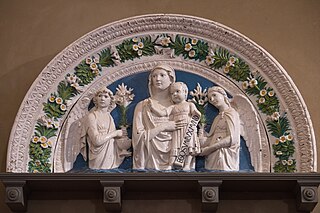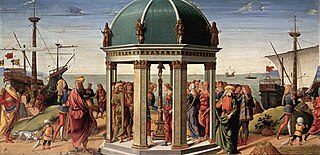
Luca della Robbia was an Italian Renaissance sculptor from Florence. Della Robbia is noted for his colorful, tin-glazed terracotta statuary, a technique that he invented and passed on to his nephew Andrea della Robbia and great-nephews Giovanni della Robbia and Girolamo della Robbia. Although a leading sculptor in stone, after developing his technique in the early 1440s he worked primarily in terracotta. His large workshop produced both less expensive works cast from molds in multiple versions, and more expensive one-off individually modeled pieces.

Cassian, or Saint Cassian of Imola, or Cassius was a Christian saint of the 4th century. His feast day is August 13.

Empoli is a town and comune in the Metropolitan City of Florence, Tuscany, Italy, about 30 km southwest of Florence, to the south of the Arno in a plain formed by the river. The plain has been usable for agriculture since Roman times. The commune's territory becomes hilly as it departs from the river. Empoli is on the main railway line from Florence to Pisa, and is the point of divergence of a line to Siena. Empoli has an enduring tradition as an agricultural centre. It has given its name to a local variety of artichoke.

Montepulciano is a medieval and Renaissance hill town and comune in the Italian province of Siena in southern Tuscany. It sits high on a 605-metre (1,985 ft) limestone ridge, 13 kilometres (8 mi) east of Pienza, 70 kilometres (43 mi) southeast of Siena, 124 kilometres (77 mi) southeast of Florence, and 186 kilometres (116 mi) north of Rome by car.

The House of Corsini is the name of an old and influential Italian princely family, originally from Florence, whose members were elected to many important political and ecclesiastical positions, including that of a Pope.

Ugolino di Nerio was an Italian painter active in his native city of Siena and in Florence between the years 1317 and 1327.

Montespertoli is a comune (municipality) in the Metropolitan City of Florence in the Italian region Tuscany, located about 20 kilometres (12 mi) southwest of Florence.

San Casciano in Val di Pesa is a comune (municipality) in the Metropolitan City of Florence in the Italian region Tuscany, located about 15 kilometres (9 mi) southwest of Florence.

Scandicci is a comune (municipality) of c. 50,000 inhabitants in the Metropolitan City of Florence in the Italian region Tuscany, located about 6 kilometres southwest of Florence.

Tavarnelle Val di Pesa is a former comune (municipality) and since 2019 a frazione of Barberino Tavarnelle in the Metropolitan City of Florence in the Italian region Tuscany. It is located about 25 kilometres south of Florence.

Galluzzo is part of quartiere 3 of the Italian city of Florence, Italy, located in the southern extremity of the Florentine commune. It is known for the celebrated Carthusian monastery, the Galluzzo or Florence Charterhouse, which was founded in 1342 by Niccolò Acciaioli.

Jacopo di Cione was an Italian Gothic period painter in the Republic of Florence.

Biagio d’Antonio Tucci was an Italian Renaissance painter active in Florence, Faenza and Rome.

Benedetto Buglioni (1459/1460–1521) was an important Italian Renaissance sculptor specialised in glazed terracotta.
Sant'Andrea is the Italian name for St. Andrew, most commonly Andrew the Apostle. It may refer to:

Santi Buglioni, by the name of Santi di Michele was an important Renaissance Italian sculptor, the nephew and collaborator of Benedetto Buglioni.

The Villa di Murlo is a rural palace or villa located in the hills surrounding San Casciano in Val di Pesa, on the old road between Florence and Siena that follows the Pesa River.

Anton Domenico Bamberini (1666–1741) was an Italian painter, mainly of religious Baroque frescoes in churches completed in a heavily ornamented and stuccoed trompe-l'œil frames and settings.

The house of Machiavelli, also referred to as L'Albergaccio, was the place where Niccolò Machiavelli lived during his exile from Florence. This is located in Sant'Andrea in Percussina in San Casciano in Val di Pesa, in the province of Florence, Tuscany, Italy

Cenni di Francesco di ser Cenni was an Italian Gothic painter active in Florence between 1369/1370 and 1415. His only signed work is the fresco of the True Cross at the Cappella della Croce di Giorno at the church of San Francesco in Volterra, painted in 1410. A couple of dozen works have been attributed to Cenni di Francesco on the basis of a similarity of style with the fresco.




















